70-man flight to Mars in 1965. Permanent manned bases on the Red Planet and the Silver Globe. Laser space stations. Ships four times heavier than the International Space Station (ISS). These are just some of the most ambitious space exploration plans. None has been realized…

Wernher von Braun in a civilian environment surrounded by military personnel, Peenemunde, 21 March 1941 (photo Bundesarchiv, Bild 146-1978-Anh.024-03 / CC-BY-SA 3.0).
SS-Sturmbannführer Wernher von Braun, was one of the fathers of American astronautics. During the war, he created the Aggregat-4 missile, better known as the V-2. He surrendered to the Americans in 1945, and then as part of a covert operation Paperclip was transferred to the United States along with many other Nazi scientists . The extraordinary mind of the designer created bold and vigorous visions.
In 1952, in Collier's weekly, he published a project for a manned orbital station - a toroid (ring-shaped geometric body) with artificially induced gravity. The first plans he drew for manned flights to the moon were to send 50 men there and set up a permanent base near Sinus Roris - the bays of one of the lunar "seas". He also planned a manned trip to Mars.
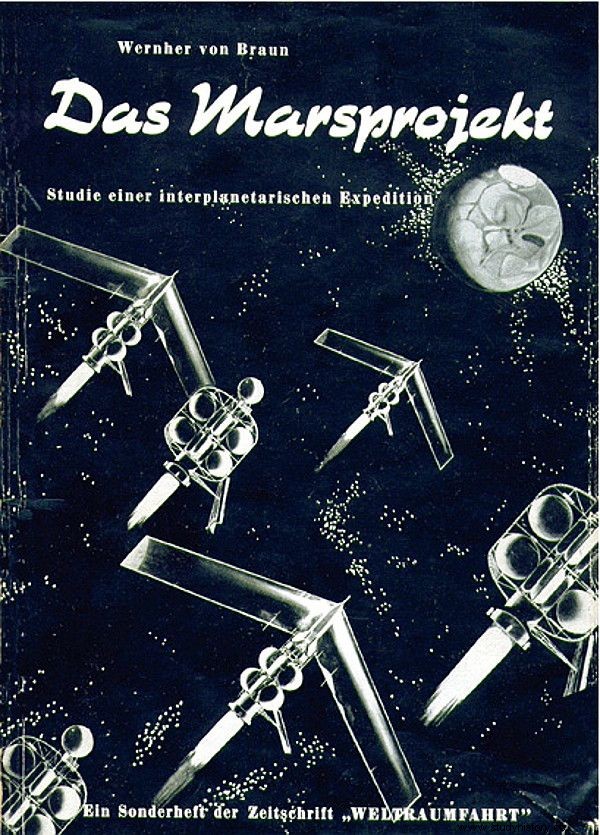
The cover of the book by Wernher von Braun entitled "Das Marsprojekt". After almost 70 years, the vision of an expedition to Mars presented in it still stimulates the imagination.
Before Von Braun became the father of the success of landing on the Silver Globe, he aimed much higher. Or maybe further. The book "Das Marsprojekt", written in 1948, translated into English and published in the USA in 1952, provided for a manned mission to Mars in 1965. The expedition was to be attended by 70 people traveling on board seven ships.
Gliders would be used for landing, and tracked vehicles for movement on the surface . The stay on the Red Planet was supposed to last one and a half years. The guarantee of success was to be ensured by a truly multidisciplinary crew, while the use of multiple ships and the separation of expeditions at successive stages was to reduce the risk. In the opinion of Mark Wade, creator of the valued Encyclopedia Astronautica , "von Braun's script is still valid" .
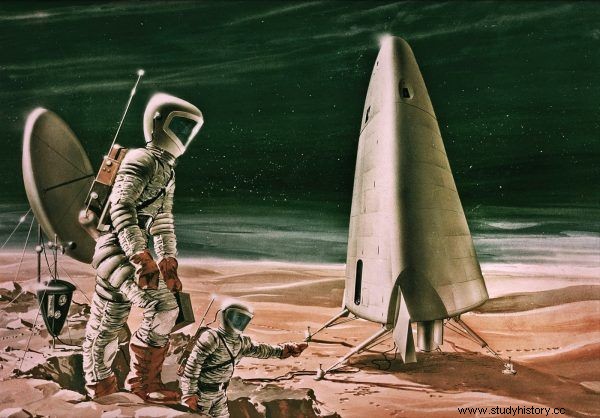
The artistic vision of a Martian lander was created around 1964 (drawing by Aeronutronic Division of Philco Corp, commissioned by NASA, public domain).
In 1962, a number of companies - Aeronutronic Ford, General Dynamics and Lockheed Missiles and Space Company - prepared a study of a manned expedition to Mars as part of the "Empire" project run by NASA's Marshall Spaceflight Center. Based on the knowledge available at that time, a mission was designed using six Saturn V rockets .
An alternative was to use a newer, stronger rocket, which, however, has not been built to this day. "Empire" was basically just a feasibility study, a project that was never funded, but it brought closer to many of the problems that astronautics faced in the years to come.

Comparison of the Saturn V (left) and N1 rockets (image by NASA, public domain).
While the imperialists of the rotten West were attempting to open up space, comrades in the Soviet Union did not neglect at all work on the same episode. One of the projects, planned on a scale worthy of the Soviets back in 1956, was the Mars Piloted Complex. The creator of the concept was Mikhail Tikhonravov.
25 N1 rockets were to be used to carry the entire structure into space , designed to fly to the moon. The finished spacecraft, assembled in orbit, was to have a mass of 1600 tons (for comparison, the International Space Station weighs approx. 420 tons) .
The mission, which lasted 900 days, was to involve six cosmonauts who were to spend the entire year on the Red Planet . The launch was planned for 1975. The Russians, however, not only did not fly to Mars, they did not even make it to the moon. One of the reasons was the completely unsuccessful design of the N1 rocket.
This article has more than one page. Please select another one below to continue reading.Attention! You are not on the first page of the article. If you want to read from the beginning click here.
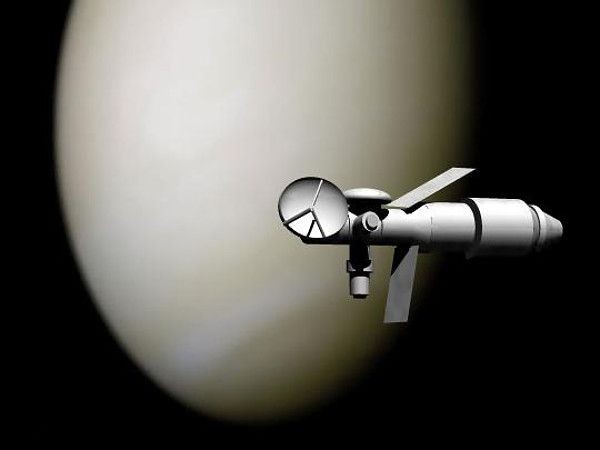
This is what the TMK-MaVr ship might have looked like during its flyby of Venus (artistic vision from 2005) (Image by KillOrDie, public domain).
The Heavy Interplanetary Spaceship (Тяжелый Межпланетный Корабль) was to be the Soviet response to the success of the Apollo program. In its original shape, it assumed a three-person flight around Mars with a 75-ton vehicle and the dropping of landers and then return to Earth after a three-year mission:from 1971 to 1974.
The development version from 1960, referred to as TMK-E, assumed a crew of six and people landed on the surface. The designed ship was so large that it was to be assembled in orbit - and this time its elements were to be carried out using N1 rockets. A variation of the project was the MaWr (Mars-Venera) mission, assuming the flight of a three-man crew both around Mars and Venus.

Artistic vision of a manned spacecraft that was to fly near Venus as part of the Apollo Applications Program (Fig. KillOrDie, CC BY-SA 4.0).
The United States, encouraged by the success of the Apollo program, planned to implement its development, the Apollo Applications Program. As part of it, missions to the Skylab station and the joint Soviet-American flight Soyuz-Apollo . One of the proposed implementations was also the Venus flyby planned for 1973.
The vehicle was to consist of a development version of the Apollo ship and a Skylab-like module (built in a similar way to the only American orbital base). The flight to the destination was planned for about four months, but the flight to the planet itself was supposed to take only a few hours. Probes intended to land on the surface were considered. It was also planned to observe the Sun and Mercury during the mission.
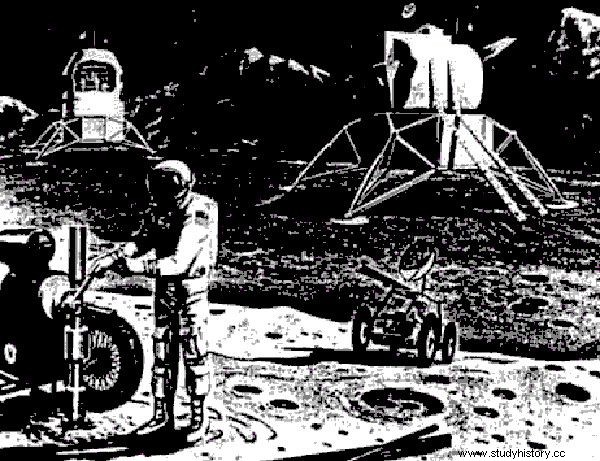
Elements of the lunar base, which was to be created as part of the Apollo Applications Program (Fig. NASA, public domain).
One of the planned uses of the Apollo Applications Program was to create a base on the lunar surface . It was assumed that the program would take longer and at the turn of 1975 and 1976 a single-module base, constructed using lunar landers from the late Apollo missions, would be deposited on the moon.
The equipment was to be shipped first, and three months later astronauts were to orbit our natural satellite on a manned mission. After leaving orbit, the resources and supplies would be sufficient for a two-week stay in the database.
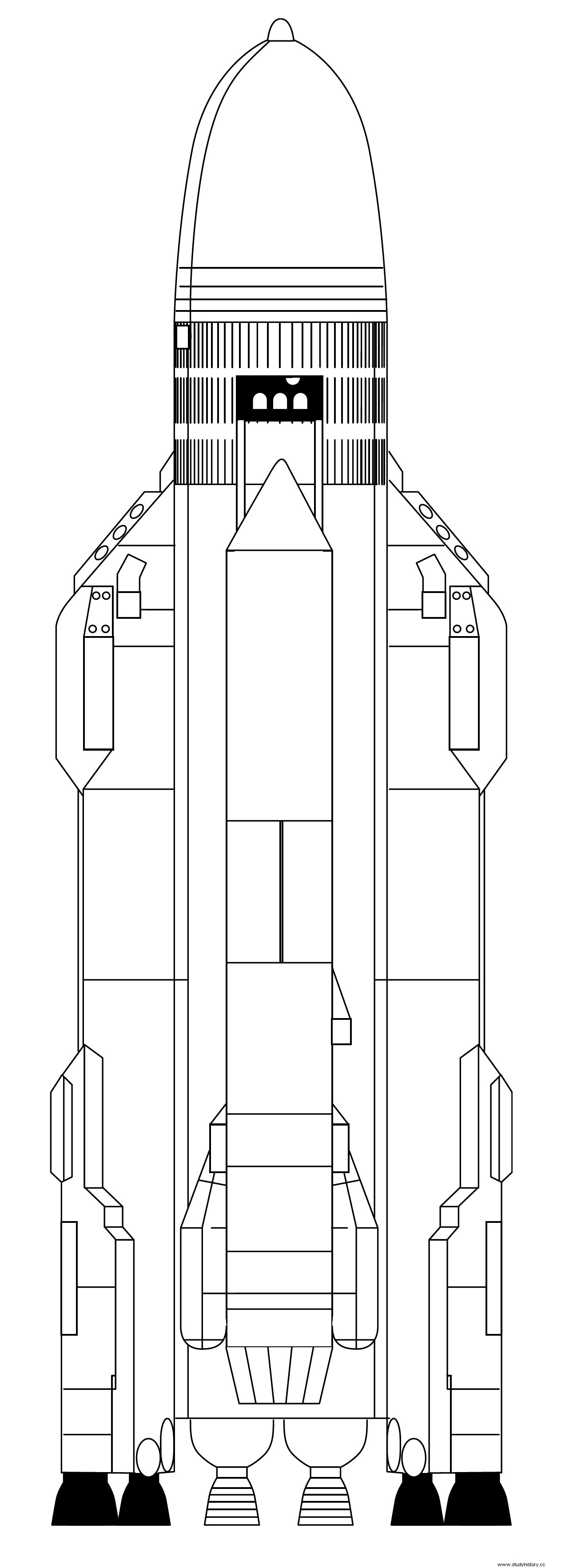
Polus on the Energia rocket (Fig. NASA, public domain).
The laser battle station is a project straight from the movie "New Hope", and yet the Russians took on such projects as well. Polus, or Skif-DM, as the prototype was actually called, was supposed to destroy imperialist satellites using a megawatt laser molecular. Work on this project was started in the 1970s.
The system was to consist of two elements:Skif in low orbit around the Earth and Cascades in high and geosynchronous orbit. On May 15, 1987, a prototype of a secret laser combat station called Polus was launched. To keep things secret and to make it harder for enemies to understand it, the name Mir-2 was painted on the hull.
The launch was carried out on the Energia rocket, also planned as a carrier for the Buran-type shuttles. After less than ten minutes, the station fell into turbulence as a result of a failure and with a ballistic flight fell into the atmosphere, where it burned down . Funding for the project ended shortly after, and some time later the Soviet Union collapsed.
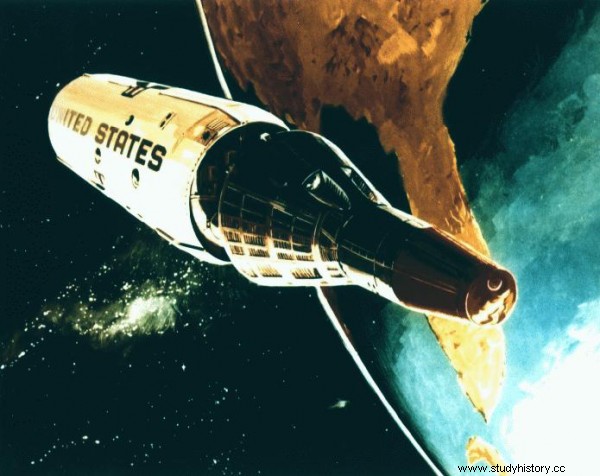
Artistic vision of MOL with Gemini B capsule (Image by U.S. Air Force, public domain).
The Americans also did not shy away from the idea of using space for combat. They were content, however, with the orbital base intended for optical reconnaissance, called the Manned Orbiting Laboratory. It was a project developed by U.S. Air Force, but due to equipment shortages it was planned to use rebuilt Gemini capsules, designed and successfully flown by the American air force .
The program assumed 30-day orbital missions to the station, using the modern Dorian telescope (code name KH-10). In 1966, a MOL model called OPS 0885 with a set of experiments was launched.
An unmanned mission lasting 75 days was planned, but after a month the equipment stopped working, and after another the facility was deorbitated. Two years later, someone in the USAF and Congress calculated the expenses and decided that spy satellites are much cheaper . The program has been deleted.
This article has more than one page. Please select another one below to continue reading.Attention! You are not on the first page of the article. If you want to read from the beginning click here.
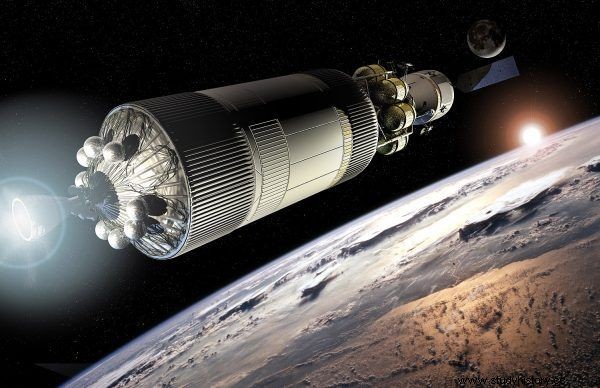
Artistic vision of the upper stage of the Ares rocket leaving Earth orbit with the Orion ship docked there (Fig. NASA, public domain).
In 2004, the then US President George W. Bush, following the example of President Kennedy, who set NASA's mission to reach the Moon, announced a new challenge. As part of the Constellation program, three goals were outlined: building a manned ship, returning to the moon and interplanetary flights .
New Ares rocket systems for launching payloads into orbit were designed, a manned mission to the Red Planet consisting of several separate phases was planned, and the construction of a ship, called Orion, began.
The Altair lunar lander, robotic probes and a series of satellites were also designed over the next six years. In 2010, Barack Obama canceled the program, and while the Orion is still in development, it is already known that the "successor to the Shuttle" is catastrophically delayed, to say the least.
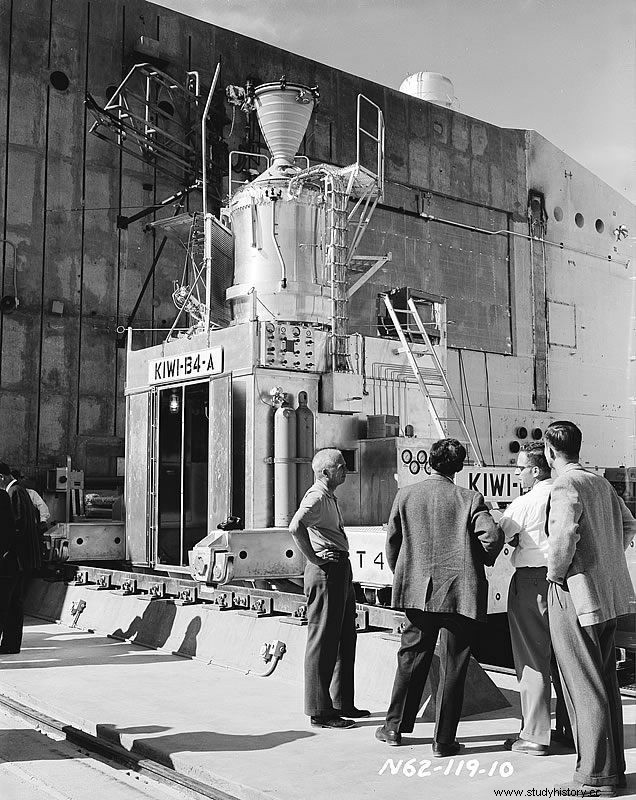
Kiwi B4-A reactor (photo:United States Department of Energy, public domain).
As early as 1952, work on nuclear rocket propulsion began in Los Alamos laboratories, which in 1955 turned into the Rover project. They proceeded so quickly and efficiently that as early as 1961 nuclear-powered rockets began to be included in space flight plans .
Even the Nuclear Space Propulsion Bureau was formed, where tests of the reactor engine were planned from 1964. The NERVA NRX engine was developed on the basis of the Kiwi reactor. In the following years, the NERVA XE design was tested, which also proved to be a success.
When all that was left was to assemble the finished drive, it turned out that the politicians had blown the matter off. The vision of the enormous costs of the planned trip to Mars terrified congressmen. The program was terminated in 1972. A similar fate befell the Soviet RD-0410.Phoenix
nuclear engine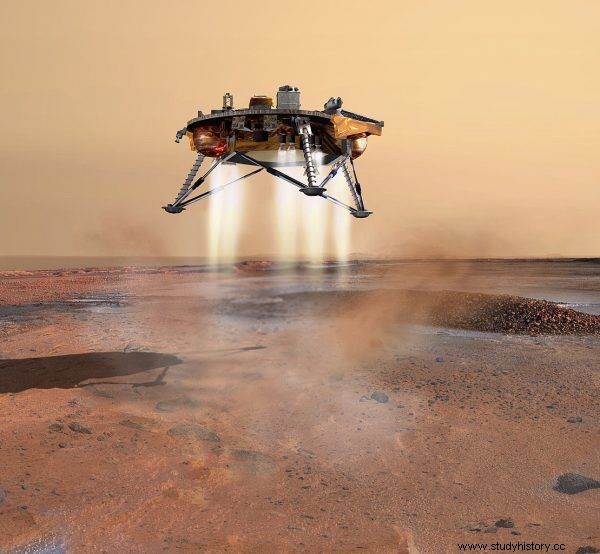
The unmanned Phoenix lander lands on the surface of Mars. In contrast to Mars One, this much more modest project was a huge success - thanks to it it was possible to confirm the presence of water on the Red Planet (Image by NASA / JPL / Corby Waste, public domain).
Quite recently, in 2011, the Mars One project, led by a private businessman from the Netherlands, started. It involved sending a mission of no return, composed of volunteers to the Red Planet various specialties who were to create a permanent base on the spot.
At first everything looked fine and the project attracted a lot of attention, mainly from the media. No wonder, because the trip was supposed to be a great reality show in the style of Big Brother . Volunteers were selected, but to date, basically nothing else has happened.
In reports from 2014 and 2015, a group of engineering students at MIT analyzed the program and left it untouched. It has been shown that the entire project has no chance of success. Some of the volunteers qualified for the flight, who were discouraged by the lack of any action, expressed a similar opinion. It looks like the miraculous plan will not only share the fate of many other projects, but is also a straightforward leap to the box office.
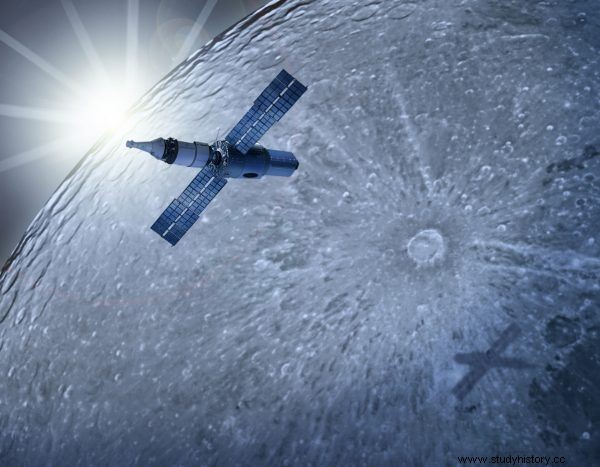
Artistic vision of the Excalibur Almaz ship in a version adapted to the expedition to the Moon (Fig. Ergignac, CC BY-SA 3.0).
Excalibur Almaz is basically an ex-company from the private space sector. A company based on the Isle of Man bought the equipment left over from the military Almaz program from the Russians:two hulls of OPS-type space stations and four WA manned capsules.
In 2009, Arthur M. Dula, the head of the company, announced the first flights for 2012. Proven, tested and well-known Soviet technology was to be a guarantee of success , and abandoning the design and testing phase resulted in huge savings.
NASA admitted EA to the Commercial Crew Program (although without funding), and an agreement was also signed with XCOR Aerospace for astronaut training and with the Space Launch System for rocket flights. Unfortunately, it quickly turned out that the retrofit was unlikely to fly anywhere. There were opinions that post-Soviet devices have at most a museum value .
In 2014, EA sold one of the capsules for a million euro and it was the company's only success. In the same year, her boss was sued by a Japanese businessman - the petition for embezzlement of less than 50 million dollars, allegedly allocated to start the business.
Apparently bad luck for the Almaz program, during which unexpected accidents happened several times he is still fine. Unlike space tourism.
***
The inspiration for this gallery was Ashlee Vance's book. Elon Musk. Biography of the creator of PayPal, Tesla, SpaceX ”(Znak Horizon 2016).
